New Material
Annual output of 100,000 tons of fully biodegradable film bag construction project of Baicheng City
1. Introduction to the Project
1.1 Project background
1.1.1 Product introduction
Biodegradable plastics refer to plastics that are degraded by the action of microorganisms existing in nature under natural conditions (such as soil, sand, etc.) or under specific conditions (such as composting, anaerobic digestion, aqueous culture medium), and finally completely degraded into carbon dioxide, methane, water, mineralized inorganic salts of the elements contained in them, and new biomass.
The project uses renewable natural biomass resources (such as starch, plant straw, etc.) or petrochemical products to produce fully biodegradable agricultural mulch films, express bags, shopping bags, tablecloths and other film bag products.
1.1.2 Market prospect
1. The development status of the degradable plastics industry
(1) Market Size
Benefiting from the promotion of national policies, the market size of China's degradable plastic reached 7.931 billion yuan in 2019. With the continuous growth of market demand, the government has promoted the penetration of degradable plastics to further rise, and since 2020, with the expansion of production capacity of some manufacturers, the market size of the degradable plastics has maintained a steady rise, exceeding 17.2 billion yuan by 2023.
Table 1 The market size of China's degradable plastics industry in the first half of 2019-2024
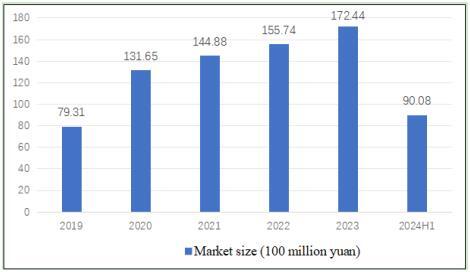
(2) Supply scale
Although China's degradable plastics industry started late, but based on the dual role of policy and market demand, the rapid development has been achieved, and at this stage China has evolved into the world's largest degradable plastics producer. With the continuous deepening of the policies and regulations of “plastic limit” and “plastic ban” promoted by countries around the world, research and development of green degradable polymer materials is one of the effective ways to solve plastic pollution. China's biodegradable plastics industry has been rapid development. In 2023, China's output of degradable plastics reached 713,500 tons, and the output in the first half of 2024 was 369,500 tons.
Table 2 The output scale of China's degradable plastics industry in the first half of 2019-2024
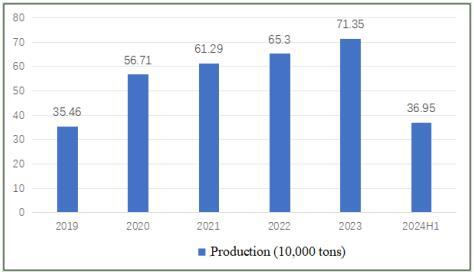
(3) The scale of demand
Since the implementation of the “plastic restriction order” in China in 2008, the demand for biodegradable plastics has maintained a high and stable growth trend. From 2009 to 2023, the market demand for biodegradable plastics in China grew by more than 30%, and in 2023, China's demand for biodegradable plastics reached 935,300 tons. In the first half of 2024, China's demand for biodegradable plastics was about 436,400 tons.
Table 3 The demand scale of China's degradable plastics industry in the first half of 2019-2024
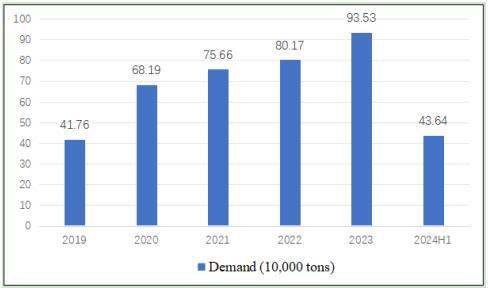
Under the background of “double carbon”, China's degradable plastics industry takes policy as a strong external driving force for development, and the alternative market has huge prospects, and the demand will achieve rapid growth and usher in new development opportunities. Especially in the fields of catering, express delivery, hotels and medical care, there is a strong demand for disposable degradable plastic products.
2. Industry segments
(1) Takeaway packaging
With the continuous penetration of Internet technology, traditional businesses in the field of catering services are actively transforming, the categories of takeaway are constantly expanding, the quality is improving, the delivery service is continuously optimized, the consumer experience is getting better and better, and the online takeaway market is developing rapidly, becoming an increasingly important new format in the catering industry.
The food delivery industry is booming, and the scale of food delivery users continues to increase. According to the 53rd “Statistical Report on the Development of China's Internet Network” released by the China Internet Network Information Center (CNNIC), the data shows that: As of December 2023, the number of Internet users in China has reached 1.092 billion, an increase of 24.8 million Internet users compared with December 2022, the Internet penetration rate has reached 77.5%, the number of mobile Internet users has reached 1.091 billion, an increase of 25.62 million from December 2022, and the proportion of Internet users using mobile phones to access the Internet is 99.9%.
In 2023, China's catering industry ushered in a historic breakthrough, with China's catering revenue of 5,289 billion yuan, a year-on-year increase of 20.4%, officially entering a new stage of development of 5 trillion yuan, of which the catering income of units above designated size was 1,335.6 billion yuan, a year-on-year increase of 20.9%. From 2018 to 2022, the average annual growth rate of the turnover of units above designated size in catering delivery and takeaway delivery services was as high as 32.04%, far exceeding the overall growth rate of the catering industry. By 2022, online food delivery revenue has accounted for 5.4% of the total revenue of the national catering industry. In 2023, China's internet platform companies will significantly increase their investment in the field of food delivery services, and continue to deepen and expand their business areas. As of December of the same year, the number of domestic online food delivery users has surged to 545 million, an increase of 23.38 million compared to December 2022, accounting for 49.9% of the total number of Internet users, reflecting the popularity and market potential of food delivery services in China.
The scale of takeaway users has expanded, and orders have increased significantly, and a large number of discarded tableware are generated every day, causing huge pressure on the environment. According to the “Detailed Standards for the Management of Prohibition and Restriction of Relevant Plastic Products” (2020 Edition), a variety of non-degradable plastic bags, including catering packaging and takeaway services, will be banned from the end of 2021. At present, due to the national plastic restriction and ban on plastics, the market space for degradable plastic tableware products to replace takeaway disposable tableware is large.
Table 4 Market size of China's degradable plastics industry in the first half of 2019-2024(tableware field)
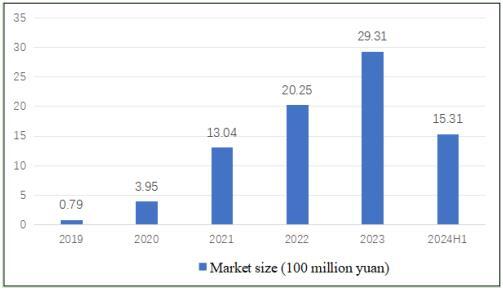
(2) Express packaging
According to the State Post Bureau, in 2023, the postal industry's mail and delivery business volume was a total of 162.48 billion pieces, a year-on-year increase of 16.8%. Among them, the express delivery business volume (excluding the parcel business of the China Post Group) was a total of 132.07 billion pieces, a year-on-year increase of 19.4%. Among them, China's plastic packaging express delivery accounts for about 41%, including plastic bags, pearlescent bags, woven bags, and foam materials. According to the “Opinions on Further Strengthening the Control of Plastic Pollution”, by the end of 2025, the use of non-degradable plastic packaging bags, plastic tapes, disposable plastic woven bags, etc. will be prohibited in postal express outlets nationwide. The plastic restriction order will stimulate the demand for degradable plastic packaging in the express delivery field.
Table 5 Market size of China's degradable plastics industry in the first half of 2019-2024(express delivery field)
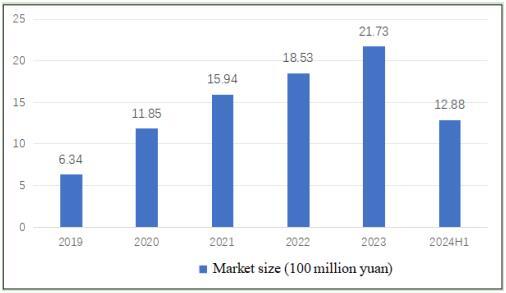
(3) Disposable packaging bags
At present, China's degradable plastics are mainly used in the packaging industry, especially the disposable packaging bags represented by shopping bags as its main market. With the in-depth implementation of the “plastic ban”, the application scope of disposable packaging bags continues to expand, and the demand has been growing rapidly, and its market size reached 10.691 billion yuan in 2023.
Table 6 Market size of China's degradable plastics industry in the first half of 2019-2024(disposable packaging field)
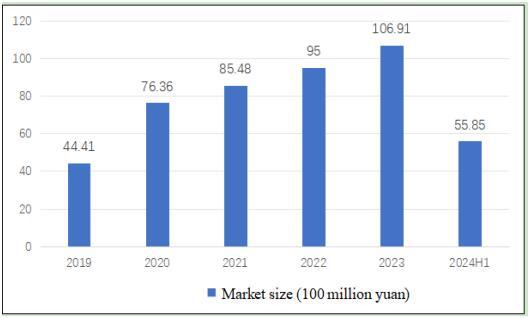
(4) Biodegradable mulch
Agricultural film is a general term for plastic film used in agricultural production, which plays a very important role in moisturizing and keeping warm during the sowing period. Agricultural film has always been an important part of China's plastic products. China Plastics Association and China Plastics Processing Industry Association data show that in the first half of 2024, China's agricultural film output was 406,000 tons, a year-on-year increase of 1.19%, with a small growth rate.
Table 7 China's agricultural film production and growth rate in the first half of 2022-2024
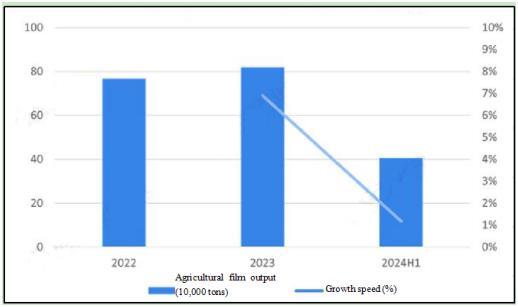
At present, there are about 1,000 agricultural film production enterprises in China, with a total production capacity of 5 million~5.5 million tons and an effective production capacity of about 4.5 million tons, more than 200 enterprises above designated size, whose output accounts for about 80% of the national output, 130 large and medium-sized enterprises, whose agricultural film production accounts for about 60% of the whole industry, and the rest are small and micro enterprises, with a market share of less than 40%.
Table 8 Market concentration of agricultural films in 2024
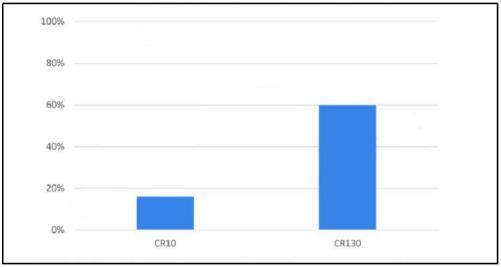
Agricultural film is an important agricultural production material in China, but the residual pollution of agricultural film in some areas is serious, which has become a prominent environmental problem restricting the green development of agriculture. With the increase in the intensity of plastic film pollution control in recent years, it is required to actively abandon the use of plastic film, and at the same time the gradual growth of the use of biodegradable plastic film, the future production of plastic film will show no increase or less increase. At the same time, with the improvement of residents' living standards, people's demand for high-quality grains and fruit and vegetable varieties is increasing, which will accelerate the research and development and application of new greenhouse films, thereby increasing the output of greenhouse films.
3. Industry competition pattern
In the global degradable plastics market, foreign companies have obvious competitive advantages, and domestic brands follow closely. In the foreign market, degradable plastics research requires a long cycle, the core technology of degradable plastics has been mastered, and foreign degradable plastic enterprises achieved the industrial mass production earlier, so foreign-funded enterprises occupy a leading position in industry technology.
At present, the output of degradable plastics in China is in the transition stage from the introduction period to the growth period, and a large number of enterprises have not achieved large-scale mass production for the time being. The enterprises that have achieved mass production include Lanshan Tunhe, Kingfa Technology, Wanhua Chemical, Home-link Technology, Hengli Petrochemical, Junzheng Group, Ruifeng Technology, etc.
The scale of domestic degradable plastic production is small and the processing cost is high, but with the expansion of the scale of the degradable plastics industry, it is expected that the processing cost of enterprises will decline, and some domestic manufacturers can also reduce transportation costs with the help of location advantages. With the breakthrough of domestic enterprises in production technology, the cost borne by enterprises is reduced, and the production capacity is gradually released, and the balance between supply and demand is realized. In addition, some degradable plastics manufacturers can integrate the industrial value chain by expanding their business downstream or by focusing on different downstream to develop customer resources and other means to reduce costs and increase efficiency, thereby optimizing resource allocation and promoting the development of the degradable plastics market.
4. Prospect forecast of biodegradable plastics industry
At present, China's annual consumption of degradable plastics is about 550,000 tons, the market size is about 11 billion yuan, and the substitution rate of non-degradable plastics is 1.2%, including 500,000 tons of packaging plastics, 40,000 tons of agricultural film plastics, and 16,000 tons in other fields; It is estimated that by 2025, the demand for degradable plastics in China will reach 2.25 million tons, and the substitution rate of non-degradable plastics will reach 4.9%, including 2.07 million tons of packaging plastics, 167,000 tons of agricultural film plastics, and 16,000 tons in other fields; By 2030, the total demand will exceed 4 million tons, and the market size will reach 80 billion yuan.
1.1.3 Technical analysis
The production technology of biodegradable mulch film is to extract straw cellulose from straw as raw material, add functional additives, and prepare straw fiber mulch film by paper copying. The straw mulch film produced by this technology has been widely used in Gansu and Xinjiang.
1.1.4 Advantageous conditions of project construction
(1) Policy advantages
The National Development and Reform Commission and the Ministry of Ecology and Environment's Notice on Printing and Distributing the “14th Five-Year Plan” for Plastic Pollution Control Action proposes to fully consider the environmental impact of bamboo and wood products, paper products, degradable plastic products and other life-cycle resources, and improve the quality and food safety standards of related products. Increase the key core technology research and achievement transformation of degradable plastics, continuously improve product quality and performance, and reduce application costs.
The “14th Five-Year Plan” for the Development of the Bioeconomy proposes to promote the application of biodegradable material products, focusing on the application demonstration in the fields of daily products, agricultural mulch films, packaging materials, textile materials, etc., to promote the reduction of production costs and improve product performance, and actively explore the market of biomaterial products.
The “Guiding Opinions on Promoting the High-quality Development of the Petrochemical Industry in the 14th Five-Year Plan” proposes to accelerate green and low-carbon development, orderly development and scientific promotion of biodegradable plastics, and promote the recycling of waste chemical materials such as waste plastics and waste rubber.
The Central Committee of the Communist Party of China and the State Council issued the “Opinions on Strengthening and Comprehensively Promoting Rural Revitalization and Accelerating the Modernization of Agriculture and Rural Areas”, proposing to fully implement the comprehensive utilization of straw and the recycling of agricultural film and pesticide packaging, and strengthen the research and development and promotion of degradable agricultural film.
The Ministry of Industry and Information Technology, the National Development and Reform Commission, and the Ministry of Commerce issued the “Work Plan for the Steady Growth of Light Industry (2023-2024)”, proposing to carry out thickened high-strength plastic film and fully biodegradable plastic film to meet the standards and improve the supply guarantee capacity of high-quality agricultural film.
(2) Resource advantages
Zhenlai County has a total of 187,300 hectares of cultivated land, 404.19 hectares of orchard land, 40,300 hectares of forest land, 41,100 hectares of grassland, 13,800 hectares of urban and industrial and mining land, 9,563.47 hectares of transportation land, 95,200 hectares of water and water conservancy facilities, and 84,200 hectares of other land.
Zhenlai County is rich in power resources, with a clean energy development area of 600 square kilometers, a total installed capacity of thermal power and clean energy of 3 million kilowatt within a radius of 100 kilometers, a full load power generation of 16 billion kilowatt hours, a total electricity consumption of 5 billion kilowatt hours and an annual surplus of 11 billion kilowatt hours. It is one of the first batch of clean energy demonstration cities and wind power local consumption demonstration areas in China. The surface water resources reserves are 10.706 billion cubic meters, and the groundwater resources are 377 million cubic meters, of which the annual recoverable groundwater resources are 276 million cubic meters.
Zhenlai County is located at 45 degrees north latitude suitable for crop growth, with 3 million mu of cultivated land and an annual grain output of more than 3 billion catties. It is one of China's important commercial grain production bases, and has been rated as “National Advanced County of Grain Production” for nine consecutive years. An annual output of 600,000 tons of corn, and an annual trading volume of 1.5 million tons. As the largest rice planting county in Jilin Province and one of the main corn producing areas, the county has an annual output of more than 1.2 million tons of straw.
(3) Industrial advantages
Zhenlai County actively promotes the comprehensive utilization of straw “five modernizations”. Successively carry out the utilization of straw fertilizer, promote and apply the implementation of no-tillage, deep ploughing and other technologies for corn straw to return to the field, the implementation of deep ploughing, deep burial, rotary tillage, spring stirring, autumn stirring and other technologies for rice straw to return to the field, and the implementation of straw and livestock and poultry manure co-treatment, and carry out the pilot demonstration of pit pond, strip stacking and other technologies; Successively carry out the utilization of feed and base materials, use large-scale breeding enterprises such as Firmus Ranch and Hehe Animal Husbandry, further implement the “straw to meat” project, expand the scale of feeding, improve the capacity of straw absorption, and develop the edible fungus industry with straw as the base material and the aquaculture industry with straw as the bedding; Promote the utilization of fuel and raw materials, and take advantage of the existing biomass power generation enterprises in Zhenlai County and the opportunity of the state to strictly control coal consumption to increase straw consumption; Promote the application of straw baling direct-fired technology in the field of heating, and promote the replacement of coal with biomass pellet fuel. At the same time, it is planned to promote the construction of new building materials, packaging materials, pulp and paper, cellulosic ethanol and other projects using straw as raw materials.
In 2023, Zhenlai County issued the “Implementation Plan for Crop Straw Leaving the Field in Zhenlai County in 2023” (ZhenNongLianZi [2023] No. 7) and the “Implementation Plan for the Comprehensive Utilization of Crop Straw in Zhenlai County in 2023” (Zhenlai County [2023] No. 4) and other documents, with a crop planting area of 3.05 million mu in the county and a comprehensive utilization rate of crop straw reaching 90%. At the same time, actively attract a number of straw utilization enterprises that master the core technology, have high added value of products, have a large amount of comprehensive utilization and strong service driving force to settle in Zhenlai, promote the specialization, intensification and industrialization of straw utilization, and continuously improve the level of comprehensive utilization of straw. At present, a total of two enterprises have settled in Zhenlai.
(4) Talent advantages
Baicheng City is home to several higher education institutions, including Baicheng Normal University, Baicheng Medical College, and Baicheng Vocational and Technological College. The city is also actively introducing Baicheng Industrial Vocational and Technological College. Once established, the college plans to enroll over 2,000 undergraduates annually from within the province and across the country, with the goal of reaching a scale of 10,000 students within 4-5 years. At that time, together with Baicheng Normal University and Baicheng Medical College, a “University City” with nearly 50,000 teachers and students will be formed, which can provide professional technological talents for the project.
Baicheng City has many scientific research institutes including the Academy of Agricultural Sciences, the Academy of Forestry, the Academy of Agricultural Machinery, the Academy of Animal Husbandry, and the Institute of Research, with 40,873 professional and technical personnel of various types, of which there are 6,898 people with senior professional titles, 18,409 people with intermediate professional titles, and 15,566 people with junior professional titles. Baicheng Academy of Agricultural Sciences is the only comprehensive agricultural scientific research institution in the semi-arid special ecological zone in western Jilin Province. It is the most cutting-edge and most important scientific research group in agricultural science and technology innovation and agricultural technology promotion in western Jilin Province.
(5) Location advantages
Zhenlai County is located in the center of Northeast Asia, the convergence zone of Horqin Grassland and Songnen Plain, the fortress of Heilongjiang, Jilin and Inner Mongolia provinces, known as “boarding three provinces”, is a gateway to the eastern part of Inner Mongolia and the western part of Heilongjiang, and is an important node city on the fourth Eurasian land bridge planned by the United Nations.
With Zhenlai County as the center and a radius of 500 kilometers, it can fully cover the industrial cities and resource-rich areas in Northeast China. Within a radius of 200 kilometers, there are 5 prefecture-level cities (Songyuan, Baicheng, Qiqihar, Daqing, Ulanhot) and 5 airports, 340 kilometers from Changchun (airport) in the southeast, 200 kilometers from Qiqihar (airport) in the northeast, 320 kilometers from Harbin (airport) in the east, 150 kilometers from Ulanhot (airport) in the west, and only 40 kilometers from Baicheng Airport. It is 850 kilometers away from Dalian Port, 120 kilometers away from Da'an Port, 620 kilometers away from Shenyang, and 1,300 kilometers away from Beijing. There are Tumen-Ulanhot Highway and Qiqihar-Shuangliao Highway in Zhenlai County, and the Siping-Qiqihar Railway, Changchun-Baicheng High-speed Railway and Nenjiang-Dandong and Hunchun-Ulanhot Expressway are intersected, so that Zhenlai County has been integrated into the two-hour economic circle and living circle of “Changchun-Jilin-Tumen (Changchun, Jilin, Tumen River) Development and Opening Pilot Zone” and “Harbin-Daqing-Qiqihar (Harbin, Daqing, Qiqihar) Industrial Corridor”.
1.2 Contents and scale of project construction
With an area of 70,596 square meters and a construction area of 84,700 square meters, the project is planned to purchase equipment of production lines and construct production workshops, warehouses, office buildings, staff living and other auxiliary rooms and other facilities
1.3 Total investment of the project and capital raising
1.3.1 Total investment of the project
The total investment of this project is 500 million yuan, including construction investment of 400 million yuan and current funds of 100 million yuan.
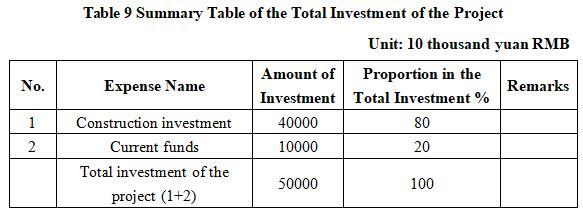
1.3.2 Capital raising
Self-funded by enterprises
1.4 Financial analysis and social evaluation
1.4.1 Main financial indexes
After the project reaches the production capacity, its annual sales income will be 530 million yuan, its profit will be 80 million yuan, its investment payback period will be 8.5 years (after the tax, including the construction period of 2 years) and its investment profit rate will be 16%.
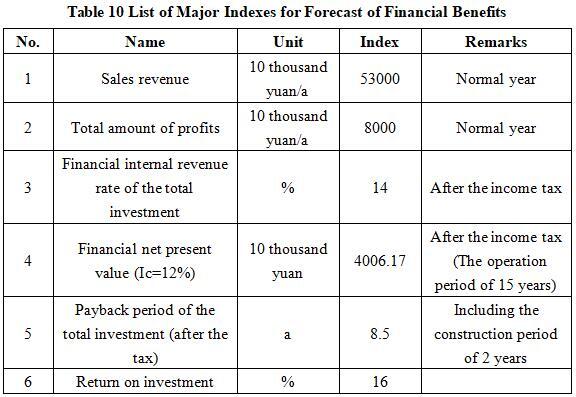
Note: “10 thousand yuan” in the table is in RMB.
1.4.2 Social evaluation
The implementation of the project will promote the transformation and upgrading of the plastics industry and promote green development and sustainable development. The use of biodegradable plastic bags in the project will effectively reduce the pollution to the environment and have positive significance for environmental protection. At the same time, it can also provide more jobs and increase the employment of personnel, which is conducive to social stability and has good social and economic benefits.
1.5 Cooperative way
Joint venture, cooperation, sole proprietorship, other ways are negotiable.
1.6 What to be invested by the foreign party
Funding, other ways are negotiable.
1.7 Construction site of the project
Zhenlai County, Baicheng City.
1.8 Progress of the project
Foreign investment attraction.
2. Introduction to the Partner
2.1 Basic information
Name: Zhenlai County Investment Promotion Office
Address: 8th Floor, Minsheng Building, Zhenlai County, Baicheng City
2.2 Overview
Zhenlai County is located in the northwest of Jilin Province, at the junction of three provinces (areas): Jilin, Heilongjiang and Inner Mongolia. It is a fusion and convergence area between the Songnen Plain and the Korqin Grassland. It is located between 45°28' and 46°18' north latitude and between 122°47' and 124°04' east longitude. The border between Jilin and Inner Mongolia is 53.35 kilometers long, and the border between Jilin and Heilongjiang is 190.1 kilometers long. It is next to Nenjiang in the east, across the river from Mongolian Autonomous County of Dorbod and Zhaoyuan County in Heilongjiang Province, Ulanhot City in the west, Tailai County in Heilongjiang Province and Zhalai Banner in Inner Mongolia Autonomous Region in the north, and Baicheng city, Da'an City and Taobei District in the southwest and south respectively.
Established in 2005 with the approval of the provincial government, with a total planning area of 18.8 square kilometers, Zhenlai Economic Development Zone was promoted to a provincial-level economic development zone in 2012, won the title of “China's New Urbanization Construction-China Demonstration Park” in 2015, and was included in the national development zone directory in 2018. The core area of the development zone has achieved “eight links and one leveling”, and the supporting construction of 3.2 kilometers of special railway line has been approved by the Shenyang Railway Bureau. Focus on the development of “four pillar industries”, namely energy development, medicine and health, agricultural product processing, and equipment manufacturing, vigorously build “three characteristic parks”, namely the food industry, equipment manufacturing industry, and food logistics industry, plan and construct “four service functional areas”, namely culture and leisure, education and health, high-end commercial and residential, administrative and financial areas, which can meet the needs of enterprises and employees in the area for production, business, residence, entertainment, financial services of different grades. It has successfully introduced large enterprises such as Firmus Dairy Group and COFCO to settle in.
At present, there are 56 enterprises in the core area of the development zone, including 11 industrial enterprises above the designated size. The pillar industries mainly cover four aspects: First, the agricultural and sideline products processing industry represented by Firmus Dairy; Second, the pharmaceutical and health industry represented by Yinnoke Pharmaceutical; Third, the new equipment manufacturing industry represented by Chenglai Electric; Fourth, the new energy industry represented by Zhonghe biomass thermal power plant.
2.3 Contact method
Postal code: 137300
Contact person: Liu Jide
Tel: +86-436-7293698 +86-13943627968
Contact method of the city (prefecture) where the project is located:
Contact person: Xu Zengchun
Tel: +86-436-3203010 +86-13894682986
Fax: +86-436-3224565
E-mail: bcjhj07@126.com


